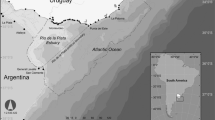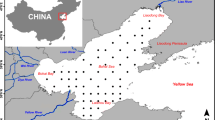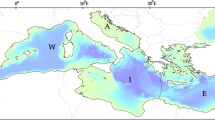Abstract
The southern Yellow Sea is an important fishing ground, providing abundant fishery resources. However, overfishing and climate change have caused a decline in the resource and damaged the ecosystem. We developed an ecosystem model to analyze the trophic interactions and ecosystem structure and function to guide sustainable development of the ecosystem. A trophic mass-balance model of the southern Yellow Sea during 2000–2001 was constructed using Ecopath with Ecosim software. We defined 22 important functional groups and studied their diet composition. The trophic levels of fish, shrimp, crabs, and cephalopods were between 2.78 and 4.39, and the mean trophic level of the fisheries was 3.24. The trophic flows within the food web occurred primarily in the lower trophic levels. The mean trophic transfer efficiency was 8.1%, of which 7.1% was from primary producers and 9.3% was from detritus within the ecosystem. The transfer efficiency between trophic levels II to III to IV to V to >V was 5.0%, 5.7%, 18.5%, and 19.7%–20.4%, respectively. Of the total flow, phytoplankton contributed 61% and detritus contributed 39%. Fishing is defined as a top predator within the ecosystem, and has a negative impact on most commercial species. Moreover, the ecosystem had a high gross efficiency of the fishery and a high value of primary production required to sustain the fishery. Together, our data suggest there is high fishing pressure in the southern Yellow Sea. Based on analysis of Odum’s ecological parameters, this ecosystem was at an immature stage. Our results provide some insights into the structure and development of this ecosystem.
Similar content being viewed by others
References
Allen R. 1971. Relation between production and biomass. Journal of the Fisheries Research Board of Canada, 28: 1 573–1 581.
Arancibia H, Muñoz H. 2006. Ecosystem based approach: a comparative assessment of the institutional response in fisheries: the case of demersal fisheries (Phase I). APEC Fisheries Working Group Report. 18p.
Brodziak J, Link J. 2002. Ecosystem-based fishery management: what is it and how can we do it? Bull. Mar. Sci., 70: 589–611.
Bundy A. 2004. Mass balance models of the eastern Scotian Shelf before and after the cod collapse and other ecosystem changes. Can. Tech. Rep. Fish. Aquat. Sci., 2 520: xii–193.
Chen J. 2004. Research on Euphotic zone depth derived from remote-sensing and its spatial-temporal characteristics over China Sea. MS Thesis. Xiamen University. 39p.
Cheng J H, Cheung W W L, Pitcher T J. 2009. Mass-balance ecosystem model of the East China Sea. Progress in Natural Science, 19: 1 271–1 280.
Christensen V, Pauly D eds. 1993. Trophic Models of Aquatic Ecosystems. ICLARM Conf. Proc. 26, 390p.
Christensen V, Walters C J. 2004. Ecopath with Ecosim: methods, capabilities and limitations. Ecol. Model., 172: 109–139.
Christensen V, Walters C J, Pauly D. 2004. Ecopath with Ecosim: A User’s Guide. Fisheries Centre of University of British Columbia, Vancouver, Canada. 154p.
Coll M, Santojanni A, Palomera I, Tudela S, Arneri E. 2007. An ecological model of the Northern and Central Adriatic Sea: Analysis of ecosystem structure and fishing impacts. Journal of Marine Systems, 67: 119–154.
Constable A J. 2004. Managing fisheries effects on marine food webs in Antarctica: trade-off among harvest strategies, monitoring, and assessment in achieving conservation objectives. Bull. Mar. Sci., 74(3): 583–605.
Dalsgaard J, Pauly D. 1997. Preliminary mass-balance model of Prince William Sound, Alaska, for the pre-spill period, 1980–1989. Fisheries Centre Research Report, 5(2): 34p.
Dong Z J, Liu D Y, Keesing J K. 2010. Jellyfish blooms in China: dominant species, causes and consequences. Marine Pollution Bulletin, 60: 954–963.
Finn J T. 1976. Measures of ecosystem structure and functioning derived from analysis of flows. Journal of Theoretical Biology, 56: 363–380.
Gulland J A. 1965. Manual of methods for fish stock assessment. Part 1. Fish population analysis. FAO Fish. Tech. Pap., 68p.
Jarre-Teichmann A, Christensen V. 1998. Comparative modelling of trophic flows in four large upwelling ecosystems: global vs local effects. In: Durand M-H, Cury P, Medelssohn R, Roy C, Bakun A, Pauly D eds. Global vs Local Changes in Upwelling Ecosystems. Proceedings of the First International CEOS Meeting, 6–8 September 1994. ORSTOM, Paris. p.423–443.
Jiang H, Cheng H Q, Xu H G et al. 2008. Trophic controls of jellyfish blooms and links with fisheries in the East China Sea. Ecol. Model., 212: 492–503.
Jin X S, Tang Q S. 1996. Changes in fish species diversity and dominant species composition in the Yellow Sea. Fisheries Research, 26: 337–352.
Jin X S, Hamre J, Zhao X Y, Li F G. 2001. Study on the quota management of anchovy (Engraulis japonicus) in the Yellow Sea. Journal of Fishery Sciences of China, 8: 27–30. (in Chinese with English abstract)
Jin X S. 2003. The change of community structure of nekton in the waters off southern Shandong Peninsula in spring. Journal of Fisheries of China, 27: 19–24. (in Chinese with English abstract)
Jin X S, Xu B D, Tang Q S. 2003. Fish assemblage structure in the East China Sea and southern Yellow Sea during autumn and spring. Journal of Fish Biology, 62: 1 194–1 205.
Jin X S, Zhao X Y, Meng T X, Cui Y. 2005. Living Resources and Habitats of Yellow Sea and Bohai Sea. Science Press, Beijing. p.38, 85–91, 100, 126–128. (in Chinese)
Jin X S, Chen J S, Qiu S R et al. 2006. Comprehensive Research and Evaluation of Fisheries Resources in Yellow Sea and Bohai Sea. Ocean Press, Beijing. p.389–398. (in Chinese)
Jin X S, Zhang B, Xue Y. 2010. The response of the diets of four carnivorous fishes to variations in the Yellow Sea ecosystem. Deep-Sea Research II, 57: 996–1 000.
Kavanagh P, Newlands N, Christensen V, Pauly D. 2004. Automated parameter optimization for Ecopath ecosystem models. Ecol. Model., 172(2–4): 141–150.
Leontief W W. 1951. The Structure of the U.S. Economy. Oxford University Press, New York.
Lin C, Ning X, Su J et al. 2005. Environmental changes and the responses of the ecosystems of the Yellow Sea during 1976–2000. Journal of Marine System s, 55: 223–234.
Libralato S, Christensen V, Pauly D. 2006. A method for identifying keystone species in food web models. Ecol. Model., 195: 153–171.
Lindeman R L. 1942. The trophic-dynamic aspect of ecology. Ecology, 23: 399–418.
Lü S G, Wang X C, Han B P. 2009. A field study on the conversion ratio of phytoplankton biomass carbon to chlorophyll-a in Jiaozhou Bay, China. Chinese Journal of Oceanology and Limnology, 27(4): 793–805.
Mace P M. 2001. A new role for MSY in single-species and ecosystem approaches to fisheries stock assessment and management. Fish and Fisheries, 2: 2–32.
Morissette L. 2007. Complexity, cost and quality of ecosystem models and their impact on resilience: a comparative analysis, with emphasis on marine mammals and the Gulf of St. Lawrence. PhD thesis. Vancouver, University of British Columbia. 260p.
Odum E P. 1969. The strategy of ecosystem development. Science, 164: 262–270.
Ouyang L J, Guo X W. 2010. Studies on the Q/B values and food consumption of major fishes in the East China Sea and the Yellow Sea. Progress in Fishery Sciences, 31(2): 23–29. (in Chinese with English abstract)
Pascual M, Dunne J A. 2006. Ecological Networks: Linking Structure to Dynamics in Food Webs. Oxford University Press, New York. 386p.
Pauly D. 1980. On the interrelationships between natural mortality, growth parameters and mean environmental temperature in 175 fish stocks. J. Cons. Int. Explor. Mer., 39: 175–192.
Pauly D, Christensen V, Dalsgaard J, Froese R, Torres F. 1998. Fishing down the marine food webs. Science, 279: 860–863.
Pauly D, Christensen V. 1995. Primary production required to sustain global fisheries. Nature, 374: 255–257.
Pianka E R. 1974. Niche overlap and diffuse competition. Proceedings of the National Academy of Sciences, 71: 2 141–2 145.
Polis G A. 1994. Food webs, trophic cascades, and community structure. Aust. J. Ecol., 19: 121–136.
Power M E, Tilman D, Estes J A et al. 1996. Challenges in the quest for keystones. Bioscience, 46(8): 609–620.
Shannon L J, Cochrane K L, Moloney C L, Fréon P. 2004. Ecosystem approach to fisheries management in the Benguela: a workshop overview. In: Shannon L J, Cochrane K L, Pillar S C eds. Ecosystem approaches to fisheries in the Southern Benguela. Afr. J. Mar. Sci., 26: 1–8.
Tang Q S. 1993. Effects of long-term physical and biological perturbations on the contemporary biomass yields of the Yellow Sea ecosystem. In: Sherman K, Alexander L M, Gold B D eds. Large Marine Ecosystems: Stress, Mitigation, and Sustainability. AAAS Press, Washington, DC, p.79–93.
Tang Q S. 1999. Strategies of research on marine food web and trophodynamics between high trophic levels. Marine Fisheries Research, 20(2): 1–11. (in Chinese with English abstract)
Tang Q S, Jia X P, Zheng Y J, Meng T X et al. 2006. The exclusive economic zone of China—marine biological resources and habitat environment. Science Press, Beijing, China. p.12. (in Chinese)
Ulanowicz R E. 1986. Growth and development: ecosystems phenomenology. Springer Verlag, New York. 203p.
Ulanowicz R E, Norden J S. 1990. Symmetrical overhead in flow networks. Int. J. Syst. Sci., 21(2):429–437.
Ulanowicz R E, Puccia C J. 1990. Mixed trophic impacts in ecosystems. Coenoses, 5: 7–16.
Wei C, Jiang W M. 1992. The studies on food web of fishes in the Yellow Sea. Oceanol. Limnol. Sin., 23(2): 182–192. (in Chinese with English abstract)
Xu B D, Jin X S. 2005. Variations in fish community structure during winter in the southern Yellow Sea over the period 1985–2002. Fisheries Research, 71: 79–91.
Zhang G Z, Li X S, Jin X S et al. 2010. Growth, mortality and optimum catchable size of small yellow croaker (Pseudosciaena polyactis Bleeker) in the Southern Yellow Sea. Journal of Fishery Sciences of China, 17(4): 839–846. (in Chinese with English abstract)
Zhang B, Tang Q S, Jin X S. 2007. Decadal-scale variations of trophic levels at high trophic levels in the Yellow Sea and the Bohai Sea ecosystem. Journal of Marine Systems, 67: 304–311.
Zhang Y Y, Chen Y. 2007. Modeling and evaluating ecosysytem in 1980s and 1990s for American lobster (Homarus americanus) in the Gulf of Maine. Ecol. Model., 203: 475–489.
Zhao X Y, Hamre J, Li F G, Jin X S, Tang Q S. 2003. Recruitment, sustainable yield and possible ecological consequences of the sharp decline of the anchovy (Engraulis japonicus) stock in the Yellow Sea in the 1990s. Fisheries Oceanography, 12: 495–501.
Zhu J C, Zhao X Y, Li F G. 2007. Growth characters of the anchovy stock in the Yellow Sea with its annual and seasonal variations. Marine Fisheries Research, 28(3): 64–72. (in Chinese with English abstract)
Author information
Authors and Affiliations
Corresponding author
Additional information
Supported by the Special Fund for Agro-scientific Research in the Public Interest (No. 200903005), the National Basic Research Program of China (973 Program) (Nos. 2011CB409805, 2010CB951204), the National Natural Science Foundation of China (No. 40976103), the Special Fund for the Basic R&D Program in the Central Non-profit Research Institutes (No. 2009-ts-10), the Taishan Scholar Program of Shandong Province, and the Yellow & Bohai Seas Scientific Observation and Experiment Station for Fishery Resources and Environment, Ministry of Agriculture
Rights and permissions
About this article
Cite this article
Lin, Q., Jin, X. & Zhang, B. Trophic interactions, ecosystem structure and function in the southern Yellow Sea. Chin. J. Ocean. Limnol. 31, 46–58 (2013). https://doi.org/10.1007/s00343-013-2013-6
Received:
Accepted:
Published:
Issue Date:
DOI: https://doi.org/10.1007/s00343-013-2013-6




